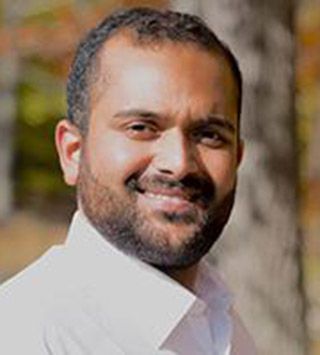Rama Sashank Madhurapantula
- Deputy Designated Dean of Academic Discipline
- Research Assistant Professor
- Student Success
- Associate Director
Education
Bachelor of Technology, Biotechnology, Jawaharlal Nehru Technological University
Ph.D. Illinois Institute of Technology
Research Interests
Rama Madhurapantula works with Joseph Orgel on understanding the structural aspects of various fibrous tissue assemblies in the human body, in non-disease and disease conditions. He is an expert in the field of in situ X-ray fiber diffraction. His primary focus for his doctoral dissertation was on the structural changes brought about by disease conditions to fibrous tissues. Specifically, X-ray diffraction, his work elucidates the changes in the D-periodic structure of type I collagen brought about by high sugar conditions (diabetes). He also worked on determining the threshold of loading force at which myelinated neurons undergo a permanent structural damage. The latter work was funded by the Army Research Laboratory and has direct relevance to understanding mild traumatic brain injury and its long-term effects. In recognition of his work in X-ray fiber diffraction, Madhurapantula was awarded the Etter Student Lecturer award by the fiber diffraction special interest group at the American Crystallographic Association (ACA) in 2014. He served as the Secretary for this group from 2013-2018. He has also been the recipient of travel awards from ACA.
His current research involves developing microscopy techniques to establish macroscopic stress vs. strain relations in body tissues that present mixed tissue compositions, in conjunction with X-ray diffraction scanning techniques to establish tissue composition. These datasets together are being used to develop a high definition model of human heart valves with accurate stress-strain finite element models to improve the characteristics of these tissues in the CAVEMAN full human body simulation, which is further utilized in simulated blast and vehicular accident calculations, and to develop a simulated surgery apparatus to train surgeons.
He is collaborating with Tom Irving and his team at IIT and BioCAT (Argonne National Laboratory) on the development of a software suite for the analysis and presentation of X-ray diffraction mapping data from large sections of animal and human tissues. He is also assisting Orgel and the BioCAT team on the development of a cryogenic X-ray diffraction mapping apparatus.
Madhurapantula was also recently elected President of CHIentist, a grassroots, non-profit organization aimed at creating platforms to enable collaborations between healthcare and life scientists from the industry and academia in the Chicago area.
Professional Affiliations & Memberships
- Sigma Xi, 2015-Present.
- American Crystallographic Association, 2012-present.
- Significant Interest Group – Fiber Diffraction, 2012-Present.
- American Society of Matrix Biology, 2015-2016.
- Sigma Nu Tau Entrepreneurship Honor’s Society (lifetime membership), Since 2016.
Publications
- 2018 Orgel JPRO, Madhurapantula RS, Eidsmore A, Wang M, Dutov P, Modrich CD, Antipova O, McDonald J, Satpathy S. X-ray diffraction reveals blunt-force loading threshold for nanoscopic structural change in ex vivo neuronal tissues. Journal of Synchrotron Radiation. In Press.
- 2018. Madhurapantula RS, Orgel JPRO. X-ray Diffraction Detects D-periodic location of Native Collagen Crosslinks in situ and those resulting from Non-enzymatic glycation. Chapter 7 – Accelerator Physics.Ahmad I and Maaza M (eds). IntecOpen. Pages 149-169. DOI: 10.5772/intechopen.71022
- 2017 Orgel JPRO, Sella I, Madhurapantula RS, Antipova O, Mandelberg Y, Kashman Y, Benayahu D, Benayahu Y. Molecular and ultrastructural studies of a fibrillar collagen from octocoral (Cnidaria). J Exp Biol. 2017. 220(Pt 18):3327-3335. DOI: 10.1242/jeb.163824
- 2017 Madhurapantula RS, Eidsmore A, Modrich CD, Orgel JPRO. New Methodology and Preliminary Data in the Characterization of the Muscle Tendon Junction of Mammalian Muscle Tissues. EMS Journal of Engineering Science. 1(1):1-7.
- 2017 Hammes M, McGill R, Dhar P, Madhurapantula RS. Asymmetric Dimethylarginine does not Predict Early Access Events in Hemodialysis Patients with Brachiocephalic Fistula Access. International Journal of Nephrology and Kidney Failure.2017 Aug;3(1). DOI: 10.16966/2380-5498.141
- 2015 Lazich I, Chang A, Watson S, Dhar P, Madhurapantula RS, Hammes M. Morphometric and histologic parameters in veins of diabetic patients undergoing brachiocephalic fistula placement. Hemodialysis International. 2015 Oct;19(4):490-8. DOI: 10.1111/hdi.12289
- 2013 Ganugapati J, Madhurapanthula RM, Sai KS. In Silico Modeling of Human Toll like Receptor 1. International Journal of Computer Applications, 61(8):19-21. DOI: 10.5120/9948-4592
Projects
- Establishing compositions of tissues that present a transition from muscle to tendon using X-ray diffraction.
- Determining the material properties of body tissues and correlating these data with the tissue compositions to establish high definition strain data, per region of samples.
- X-ray diffraction on collagen, amyloid, silk, hair from dinosaur fossils.
Expertise
- Biophysics and Structural Biology: Crystalline and non-crystalline fiber diffraction, macromolecular crystallography, brain and connective tissue imaging, synchrotron X-ray radiation applications to biophysical and biomedical problems.
- Cell & Tissue Architecture, Basic and Applied Medical Research: Collagen and extracellular matrix structure, connective tissues and associated diseases.
- Diabetes: Human tissue structure function in diabetics, End-stage Renal Disease, vasodilation, vasoconstriction and vascular ultrastructure and underlying collagen involvement in diabetics.
- Tissue Engineering: Novel methods to create collagenous implants for repair of injuries, joint replacement and regeneration.
- Neuroscience: Structural basis of Traumatic Brain Injury (TBI), Post-traumatic Stress Disorder (PTSD), Alzheimer's, demyelination and its relevance to the progression of these diseases.
- Biomedical Instrumentation: Novel 2D and 3D microscopy, multimodal imaging.
- Software Development: X-ray diffraction and fluorescence mapping, 2D and 3D microscopic image reconstruction.


